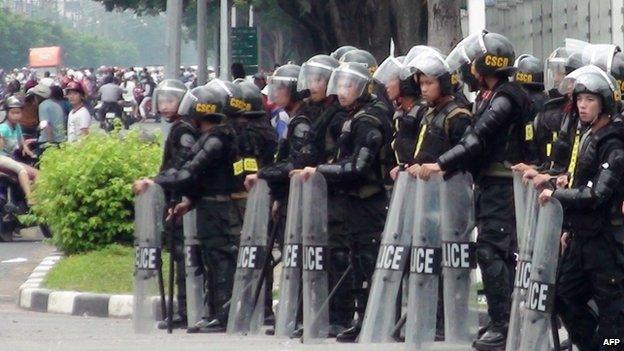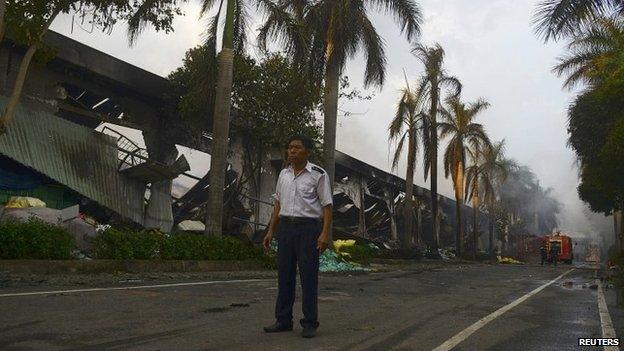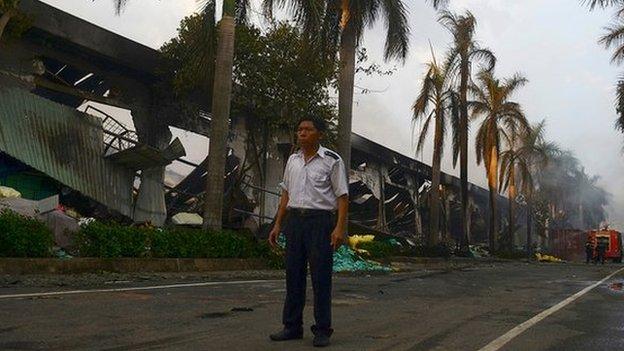Vietnam-China tensions: Why protests are not just jingoism
- Published

Vietnamese protesters have targeted foreign-owned factories amid anti-China anger
Dramatic images of Vietnamese workers vandalising Chinese-owned factories appear to be yet more proof that an angry nationalism is taking hold in East and South East Asia.
The reality is a little more complex. Although passions are certainly rising over the fate of a few specks of rock in the South China Sea, this is not simply jingoism at work.
The first clue is that those most of the "Chinese" factories that are being smashed up aren't, in fact, Chinese.
Journalists have no access to the industrial parks where the protests have been concentrated so we can only make informed guesses about what is going on and why.
However, going on the information reaching my colleagues in the BBC's Vietnamese Service, the riots tell us more about the conditions inside those factories than about geopolitics.
This is not to deny that many Vietnamese are livid about China's attempt to drill for oil in waters claimed by Vietnam. There were angry protests about the issue outside the Chinese embassy in Hanoi and its consulate in Ho Chi Minh City over the weekend.
These were the usual small affairs and they were tolerated by the government. That tolerance can be explained by the ruling Communist Party's need to impress two audiences: its own people and its foreign sparring partners.
The Communist Party of Vietnam is an intelligent organisation. It knows that there is widespread anger about China's moves in the South China Sea (or the East Sea as it is known in Vietnam).
It also knows that its critics, particularly overseas-based anti-communists, accuse it of kowtowing to China. If it cracks down too hard on "patriotic" demonstrators, the party will be accused of betraying the national interest.
It also knows that its negotiating position with China will be much stronger if it can prove that the domestic cost of making compromises will be too great.
This is the usual explanation for instances of anti-China demonstrations in Vietnam (and, not coincidentally, also of anti-Japan protests in China).
The party is furious about China's installation of an oil rig near the Paracel Islands. A bit of street action helps to bolster its position in dealings with its brother communists in Beijing and allows hotheads to let off a bit of steam.
'Invaders'
However, the scale and extent of the vandalism and rioting that we have seen in the past few days is something new and shocking. It has a different explanation.

Worker grievances are a factor in these protests, which erupted earlier this week
There are several accounts of what triggered the rioting. Some say it began at an officially-sanctioned protest that got out of hand. Others have suggested that an American-based organisation of anti-Communist Vietnamese exiles, Viet Tan, may have played a role.
Both may be true but neither would explain why the protests became so large and so violent so quickly. There are other factors at work.
Thomas Jandl is an expert on Vietnam, based at American University in Washington DC. He points to the growing discontent among Vietnam's rapidly-growing industrial workforce.
"Riots can easily start over minor issues that then get conflated with others. These are factory workers, not political science or history scholars. They have 'Chinese' overseers, they feel that these people are not nice to them and now they - or someone like them - is invading the country," he says.
Over the past few years there have been dozens of strikes at foreign-owned plants in Vietnam. Complaints about low pay, bad workplace conditions (poor canteen food, limits on using the toilet and so on) and bullying management have triggered disputes.
These complaints have focused on plants owned by Taiwanese and Korean companies in particular. However, Thai and Singaporean plants have also been affected.
Perfect storm?
To these traditional complaints, a major new one has been added. Some factories, particularly Taiwanese-owned plants have been employing Chinese workers in favour of local Vietnamese.

Many of the factories targeted have been owned by companies that are not Chinese
This appears to have been the trigger for the trouble in the central province of Ha Tinh, in which one Chinese person was killed and 90 others injured.
What we are witnessing in Vietnam is an inchoate sense of anger - partly against China but more urgently against bad employers. This is a nightmare scenario for the Communist Party of Vietnam.
It will be easy for protestors to paint it as betraying the national interest out in the South China Sea (by failing to stand up strongly enough to China) and weak at home for failing to ensure that foreign companies treat their workers fairly.
Add in a myriad of other personal and local grievances and a wrong move could stir up a perfect storm of anti-"system" protest.
The party has the means to put hundreds of thousands of security personnel on the streets within hours if the threat to its rule becomes significant. However that would be a last resort for an organisation that claims to be the living embodiment of the people's will.
The ramifications of the decisions the party takes in the next few days will be felt for some time.
Bill Hayton, who works for BBC Media Action, is the author of Vietnam: rising dragon (Yale 2010) and The South China Sea and the struggle for power in Asia, to be published by Yale in September.
- Published16 May 2014

- Published15 May 2014

- Published14 May 2014
